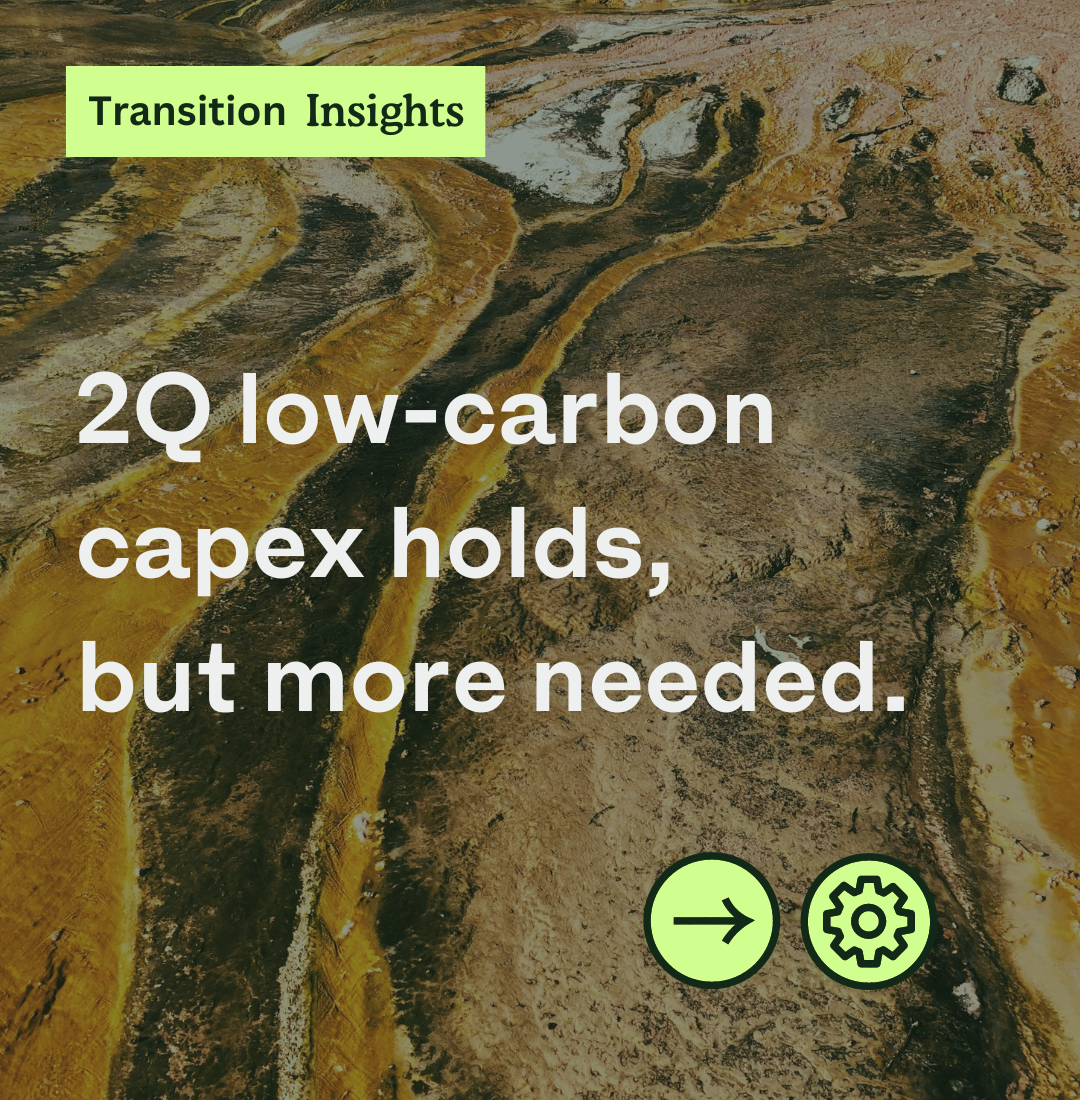2Q 2024 Results | Climate Transition Insights
This report comprises general statements of factual information and not financial advice. Read our Important Notice.
This report assesses the Oil and Gas majors’ 2Q 2024 results and progress on transition, highlighting key engagement questions for 2025.
Companies assessed: BP, Shell, Eni, TotalEnergies, Equinor, Woodside and Santos.
Our view
The transition plans of Majors are being tested, and the reality of the growth in low-carbon investment required to execute emissions targets is becoming clear. As 2025 nears, companies must align targets with actionable strategies. They can either set plans to achieve their targets - addressing investor concerns by showing low-carbon investment value or adjust targets to reflect continued oil and gas, evidenced by 1H24 production growth and aggressive moves in LNG.
Investors engaging with oil and gas should consider these engagement questions ahead of 2025:
01 Will majors quantify levers to achieve net carbon intensity (NCI) targets?
This includes levers such as offsets, CCS, and divestments. From FY19-23, major NCI reduced by only ~4%, with FY30 low-carbon ambitions insufficient to deliver the emission reduction, leaving up to a 15% gap.
In 2Q24, majors further diverged from targets, expanding LNG portfolios and reaching the highest oil and gas production levels since FY22.
02 How can majors Increase low-carbon investment?
Low-carbon capex hit $2.9bn in 2Q24, a 4% YoY increase, but below the 19% average of the last 3 quarters.
To meet NCI targets, majors must invest an additional $134bn ($19bn p.a.) above current investment targets.
Key findings
-
Concerns in 1Q24 about prioritising distributions have eased, with 2Q distributions stabilising at $16.5bn—a 22% drop from FY23’s average.
Despite a 6% capex decline to $20bn from 2Q23, low-carbon investment rose 4% to $2.9bn. The percentage of low-carbon capex dropped to 13% of total, down from a ~19% average over the prior 3 quarters, but comparable to 12% in 2Q23.
-
It was an eventful quarter for biofuels, with a surge in supply from China impacting margins, Shell pausing construction at its 820 kt/yr Rotterdam facility, and BP scaling back projects in Germany and the US, raising investor concerns about the role of biofuels in the energy transition.
We believe the ambitions of oil majors’ bioenergy remain intact, with BP (100 kb/d, $4bn EBITDA) and Eni (3 Mtpa biorefining capacity) appearing on track to meet targets as long as BP’s Kwinana, Rotterdam, and Castellon projects are not delayed and margins do not further deteriorate. As FY23, BP is the largest of the majors for bioenergy production at 32 kb/d, followed by Eni ~28 kb/d, and Shell ~24 kb/d.
-
Low-carbon capex for the sector hit $2.9bn in 2Q24, a 4% increase from 2Q23 to 13% of total capex. This was well below the ~19% average of the last 3 quarters.
We see risk to low-carbon capex targets, with quarterly capex continuing to lag. BP FY25 capex target is most ambitious at 50%, but tracking at just 23% in 1H24.
-
Demonstrating value from low-carbon remains the key to unlocking investment needed to meet emissions targets.
TotalEnergies has been most consistent, earning $502m in 2Q24 (Integrated Power) - its fourth consecutive quarter over $500m.
BP follows, averaging ~$300m for 1H 2024 (Transition Growth Engines). Earnings must scale up by FY25, with BP reaffirming its $3-4bn target.
Eni’s earnings fell 34% to €143m (Enilive and Plenitude) due to a 52% drop in Enilive’s biofuel margins.
Shell’s Renewables & Energy Solutions posted a loss of $187m compared to adjusted earnings of $238m in 2Q23.
Equinor’s Renewables segment remains unprofitable, with an $85m loss in 2Q24. Notably, Equinor’s segment excludes gas power and retail gas, unlike other majors.
-
1H24 oil and gas production reached 12.26 Mboe/d, up 2% from 1H23. Production has increased every half-year since 1H22, averaging a growth of 100 kboe/d per half.
In 2Q24, European majors made significant moves to expand their LNG portfolios. Companies continue to market LNG as a transition fuel, however its ability to decarbonise a portfolio is limited.
Shell acquired Pavilion Energy (6.5 Mtpa contracted portfolio), secured a 10% stake in Adnoc’s Ruwais LNG project (9.6 Mtpa), and took FID on the Manatee gas field.
TotalEnergies increased its Integrated LNG capex by 40% to $822m, acquiring a 20% stake in Texas's Dorado Gas field (50 Mcf/d) and contribute to LNG production in the US, and signing contracts that will add 3 Mtpa to its LNG portfolio.
BP approved the FID for the Coconut project in Trinidad and Tobago, set to supply gas to Atlantic LNG, where BP and Shell each hold 45% equity. BP also reported a 25% increase in its Gas segment capex, reaching $869 million.
Woodside’s $1.2bn acquisition of U.S. LNG developer Tellurian, including debt, signals a firm commitment to LNG for the future over low-carbon ‘New Energy’ offerings. Projected development costs total $26bn, with ~$13bn attributable to Woodside post-sell-down. This far exceeds Woodside’s $5bn New Energy investment target.



